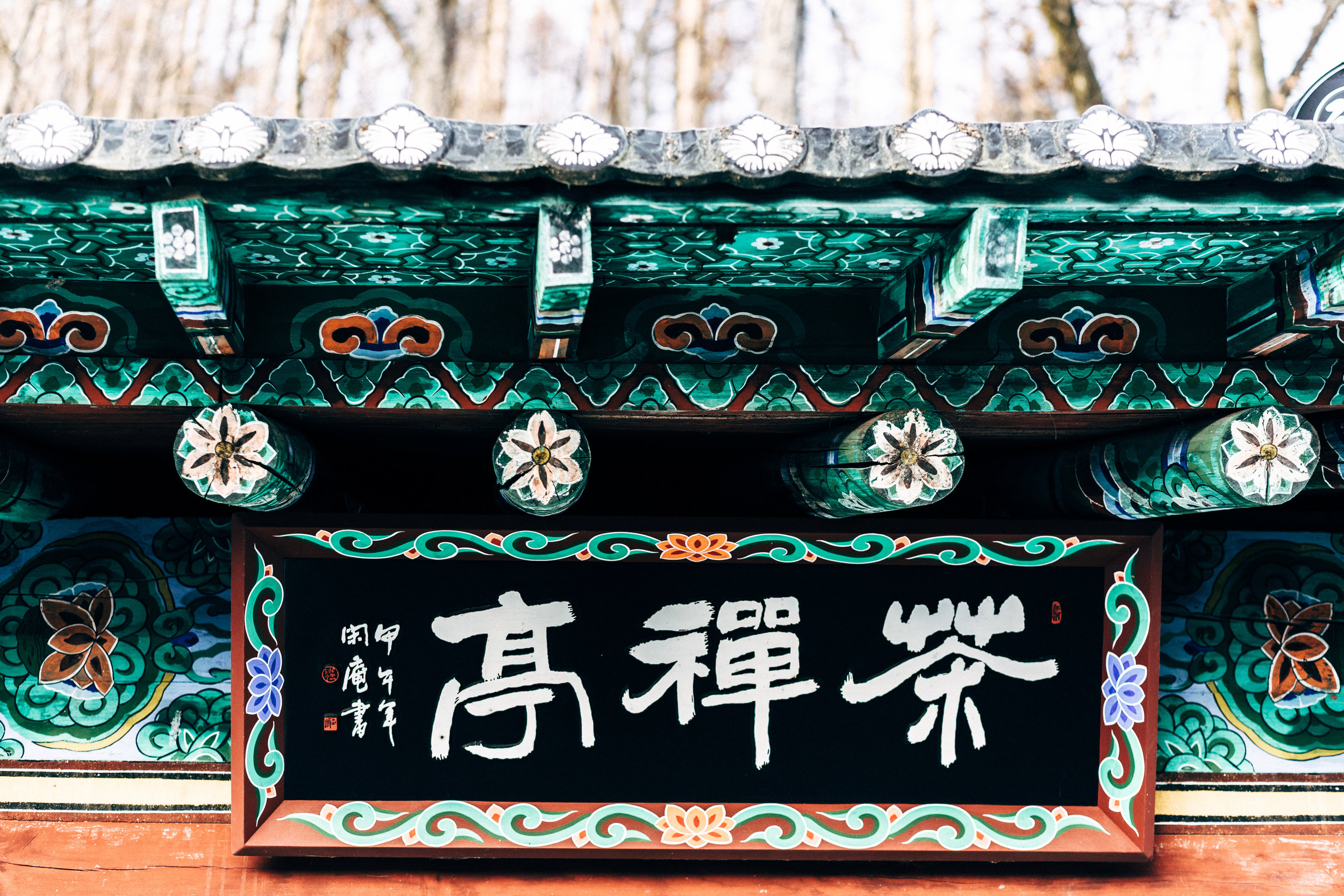My Introduction

The first time I tried Korean Buddhist temple cuisine I was around twelve years old. My mother and I went to Sanchon, one of the oldest existing temple cuisine restaurants in Seoul. It was and still is tucked away in an alley of the old antiques district. My mother, her closest friend and I sat on the floor at a traditional low table with reminders of the chef’s former monastic life strewn around. My foot began to prickle, but I ignored it as the table quickly filled with multitudes of small dishes with plants and vegetables that I had never seen before. When I asked my mother what all of these vegetables were, her reply was simply “they’re Korean mountain greens”. “Oh really? Thanks Mom, that’s helpful.” I most definitely rolled my eyes as well, when she wasn’t looking of course.
I later realised that my mother really couldn’t say much more because there are just too many of these obscure mountain greens in Korea. These plants certainly couldn’t be found in the fields of Virginia where my family was, and who could possibly remember their formal Latin appellations? Codonopsis lanceolata (더덕) or ligulari fischeri (곰취나물) anyone? It doesn’t matter what they’re called, they are delicious. Now whenever I come back from trips to Korea, my bag is filled with these greens if I can find them – not because I grew up with them but because for me they represent one of the most exciting aspects of Korean cuisine.
Since that first meal in Sanchon so many years ago, I also try to have a Korean Buddhist meal every time I visit Korea. My favourite right now is Baru Gongyang, which is tied to the Jogyesa temple in Jongno-gu, Seoul and serves an elevated and visually arresting tasting menu of Buddhist dishes. This is vegan food like none other, and I want to learn to make all of it. Luckily, the Jogyesa temple also runs a cooking school for those who want to learn to make Buddhist temple cuisine.
After spending months poring over Buddhist cookbooks I bought in Korea, I recently went to the Jogyesa cooking school and also stayed in a temple north of Seoul to get a glimpse of life in a temple and the food within it. I stayed at Daewonsa temple which is a two-hour drive north of Seoul, near Gapyeong which is famous for their pine nuts (I also bought a kilo of pine nuts on the way). My cousin came along with me and we found out when we arrived that we were the only guests at the temple. The winter doesn’t see many visitors since it’s bitterly cold. There was snow on the ground, and we wore layers underneath the intentionally unflattering clothing we were given at orientation.
During orientation, we learned to appreciate that we were simply visitors who mustn’t disrupt the monastery life. Temple etiquette dictates which doors laypeople can use to enter a temple (the side door only), how to hold our hands properly when bowing to a passing monk (with your palms pressed together right below your chest, arms and elbows in a straight line perpendicular to your palms) and how to walk around the grounds (with your hands folded in front of you, never in your pockets).
Bells rang at 4am, with morning prayers right after; breakfast was at 6am; more prayers and meditation; lunch at 12 noon; etc. Since we were the only guests, we often ate alone with the cook who seemed happy to have someone to ask her about the food. We had an intimate tea with the presiding monk who was younger than I am and had a warm laugh. "Many people come here for the weekend to rest and restore themselves so they can go back to work on Monday with full strength."
Life in the temple, coming from Hong Kong and Seoul, has a completely different pace. Even with the set schedule, there was a lot of quiet time – a lot. I don’t often have quiet time, and I also don’t often have time with my cousin who lives in Seoul. You realise that time really is a gift, and I’m grateful to have had that. I’m set to go on a longer stay at another temple in a couple of weeks, so I can learn even more about temple culture, and especially the cuisine.
For the last 1,700 years, temple cuisine has been a core part of Korean Buddhist monastic life. The mindfulness emphasised in Buddhist philosophy extends to food. Meals are eaten in silence, after giving thanks. At the start of the periodic formal monastic meal called baru gongyang (thus the restaurant name), this prayer is said by the presiding monk: Where has this food come from? May I be worth of receiving it. May I renounce the unwholesome mind, especially the poison of greed. May I take only food enough to sustain the body and prevent illnesses, and may I accept this food to attain enlightenment.” Eating is a spiritual practice in and of itself.
Adhering to Buddhist tenets of compassion and interconnectedness of all beings, temple cuisine is completely vegan. This means there is no meat, dairy or eggs. Monks are not permitted to kill for food, nor purchase food that is the result of animal suffering. As the monk at Daewonsa temple told us, monks can eat meat if they are given it by someone else (such as when monks ask for alms). But within the temple, all of the food is vegan. So, temple cooks have to carefully construct their dishes to ensure the food is nutritious and nourishing both physically and spiritually.
Recognising that food has the power to influence both the mind and the body, Buddhist cuisine actually forbids garlic, green onions and other alliums. These are considered to be heating or stimulating, specifically of the libido, which would be distracting for those who have vowed to lead a monastic life, if you get my drift. Temple cooks have a fluency with the medicinal effects of various plants, roots and herbs that they forage for to which the West is currently catching up. Buddhist recipes use cooking techniques that highlight and not diminish the medicinal benefits of ingredients.
Temple cuisine is also inherently seasonal, as the Buddhist practice includes cultivating and foraging local plants and herbs. Springtime is a glorious time for temple food due to the abundance of those famous Korean mountain greens. Because Korean winters are harsh and long, autumn means preserving fresh produce in any way possible. Plants are dried in the sun, fruits are preserved in their own syrup, vegetables are pickled in soy or fermented with red pepper. Soy sauce and kimchi, imbued with umami, are the foundation for temple cuisine and replace the depth of flavour of the missing garlic. I never would have imagined Korean cuisine could exist without garlic, but in the right hands, you would never know the difference.
Another key element of Korean Buddhist cooking is a zero-waste philosophy. At the daily communal meals, one only takes as much as food as one can eat, and you are not permitted to leave any food in your bowl. This spirit also extends to how food is prepared so that all parts of food are used. Fruits are usually eaten with their peel; the cloudy water used to wash rice is saved for soup; leftover vegetable bits are thrown into a stock. It’s like nose-to-tail cooking without noses or tails… As I’ve mentioned before on this blog, this kind of mindful consumption is something I’ve been exploring in my kitchen, where I’ve been pickling daikon peels and trying to think of other ways to use up my food scraps.
With their seasonal, adaptogenic, fermented, foraged superfoods and plant-based, zero-waste mindsets, Korean Buddhist temple cooks since the 4th century have quietly been living the food-related principles that contemporary society is now talking about. It’s just a matter of time before a Korean temple restaurant opens in Williamsburg or Silverlake – I just hope that it’s mine. More to come on the nuances and flavours of Buddhist cuisine, along with recipes, in the coming weeks…
xx Mina
















